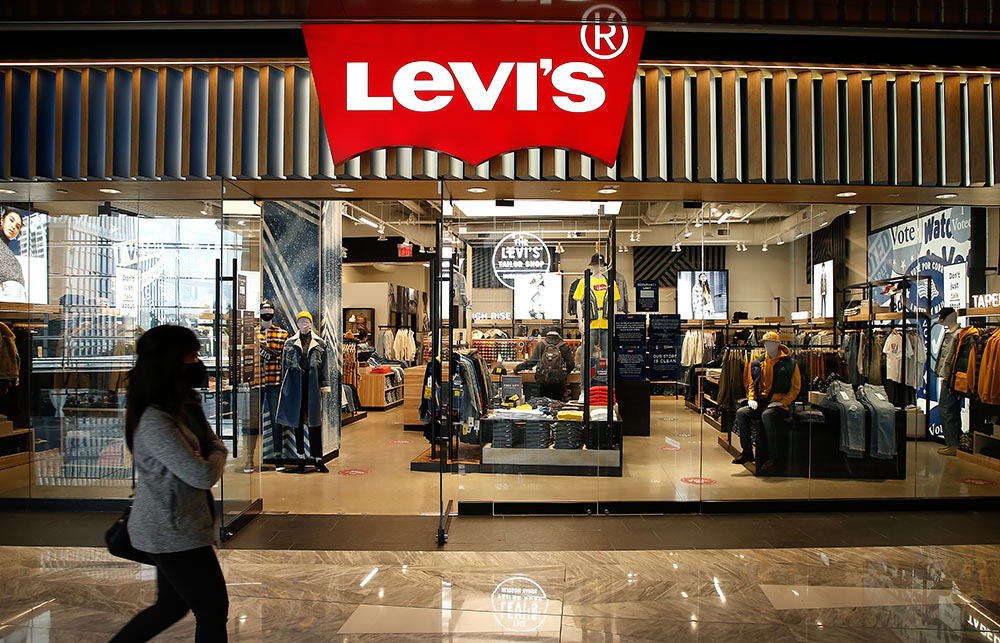李维斯入驻塔吉特,百货公司慌了

去年,李维斯(Levi’s)宣布了在塔吉特(Target)的140间门店销售其代表性的红标牛仔裤,这对那些销售李维斯产品的百货公司而言无疑是个坏消息。
虽然李维斯旗下的超低价品牌丹宁镇(Denizen)一直在这家折扣零售商销售,但其高管一直不太希望将自家在梅西(Macy’s)、彭尼(J.C. Penney)、西尔斯(Sears)、贝尔克(Belk)等百货店销售火爆的旗舰产品推向塔吉特这样的大卖场。
然而,如今传统百货业深陷“关门潮”,反观塔吉特却是一派欣欣向荣的景象。正是在此背景之下,李维斯决定加倍扩大与塔吉特的合作规模,并于上月宣布将双方合作门店数量增至500家。
今年10月,李维斯宣布,计划在部分迪克体育用品商店(Dick’s Sporting Goods)销售旗下产品,这一消息无疑给商场零售企业带来了更大的压力。与塔吉特一样,迪克体育用品店也主要分布在购物街区。作为李维斯的长期合作伙伴,科尔士(Kohl’s)也是购物街区的“老面孔”,李维斯的首席执行官切普·伯格表示与之合作空间还很大。
虽然李维斯把建设自营门店和网站作为优先选项,但仍然无法改变其对零售商的依赖,该公司2019年销售额的70%都来自北美批发业务。
长期以来,购物中心的百货店一直是李维斯主要的销售渠道,但受新冠疫情影响,李维斯全球销售额急剧下滑(上季度销售下滑26%),于是,该公司决定转而投向新的零售商群体。
伯格在接受《财富》杂志采访时说:“某种意义上说,我们只是调整了自己对客户的看法、保持了开放的心态而已。”他又补充道,李维斯高管团队考量的问题其实很简单,那就是“谁更得消费者的欢心?我们如何才能够与之一起赢得消费者的喜爱?”
事实证明,购物街区更受欢迎。百货公司已经失去了对消费者的吸引力,肮脏混乱的环境、乱七八糟的商品组合、毫无秩序的店铺排列都让消费者望而却步。相比之下,塔吉特、迪克体育和科尔士等商家的门店就维护得很好,而且与商场相比,这些门店距离消费者也更近。
据伯格介绍,即便在其2011年上任公司首席执行官后,李维斯高层对塔吉特的成见依然存在,他说:“当时大家总以为那些去大卖场购物的消费者不会买我们的产品。”
在谈及塔吉特时,伯格表示:“他们能够吸引到客流,自然就可以帮助我们卖出去东西。”迪克体育与李维斯的合作虽然刚刚起步,规模也不大,但在为李维斯引入新客群方面已然颇有建树,(凭借良好的合作成果,)双方的合作很可能还会进一步扩大。相较于塔吉特售价40美元的牛仔裤,李维斯在迪克体育销售的牛仔裤价格更贵,通常为70美元。
而正在竭力避免陷入彭尼百货和梅西百货相同困境的科尔士,则为李维斯触达“妈妈消费者”提供了机会,这是牛仔裤品牌十分看重的消费群体。女性产品贡献了李维斯超过三分之一的营收,远超伯格上任首席执行官时的比例,但仍未达到该公司预期的水平。科尔士削减数十个自有品牌的行动让伯格看到了机会。他说:“李维斯拥有极强的品牌实力,但我们的女性业务还有很大的提升空间。”
不过,伯格很快补充道,虽然彭尼百货现在的门店数量只有其鼎盛时期的三分之一,但考虑到其与梅西百货的影响力,这些百货公司仍然是李维斯不可或缺的合作伙伴。
增加门店数量,缩小门店规模
考虑到直营店能够给企业带来更高的收益和更大的控制权,无论批发零售渠道的组合如何变化,李维斯仍然会将直营业务作为其提升业绩的主要着眼点。
李维斯在全球拥有约3100家门店,但真正由该公司拥有和经营的只有约850家,其余则为特许专卖店,主要分布在美国以外地区。如果再去掉工厂直销店,那么李维斯在全美拥有的常规门店数量将进一步减少到35家。
伯格指出,在波士顿等城市,距离市区最近的李维斯门店竟然在远郊的奥特莱斯,这也让他看到了开设更多常规门店的机会。面向美国消费者的新一代门店将借鉴欧洲门店的风格,面积一般在280平方米左右,远小于美国本土现有门店的规模。伯格表示:“我们不会把所有的产品都塞到这些门店销售。”
也就是说,虽然伯格认为美国市场有足够的空间让李维斯再开100家门店,但这些门店更可能会走“小而美”的路线。此外,由于李维斯北美市场的大部分销售额依然来自批发业务,而且这种情况在可预见的未来不会发生改变,李维斯预计将继续借助新晋零售合作伙伴的力量提升业务份额。伯格说:“我们在市场上表现不俗,不过还是要再接再厉才行。”(财富中文网)
译者:梁宇
审校:夏林
去年,李维斯(Levi’s)宣布了在塔吉特(Target)的140间门店销售其代表性的红标牛仔裤,这对那些销售李维斯产品的百货公司而言无疑是个坏消息。
虽然李维斯旗下的超低价品牌丹宁镇(Denizen)一直在这家折扣零售商销售,但其高管一直不太希望将自家在梅西(Macy’s)、彭尼(J.C. Penney)、西尔斯(Sears)、贝尔克(Belk)等百货店销售火爆的旗舰产品推向塔吉特这样的大卖场。
然而,如今传统百货业深陷“关门潮”,反观塔吉特却是一派欣欣向荣的景象。正是在此背景之下,李维斯决定加倍扩大与塔吉特的合作规模,并于上月宣布将双方合作门店数量增至500家。
今年10月,李维斯宣布,计划在部分迪克体育用品商店(Dick’s Sporting Goods)销售旗下产品,这一消息无疑给商场零售企业带来了更大的压力。与塔吉特一样,迪克体育用品店也主要分布在购物街区。作为李维斯的长期合作伙伴,科尔士(Kohl’s)也是购物街区的“老面孔”,李维斯的首席执行官切普·伯格表示与之合作空间还很大。
虽然李维斯把建设自营门店和网站作为优先选项,但仍然无法改变其对零售商的依赖,该公司2019年销售额的70%都来自北美批发业务。
长期以来,购物中心的百货店一直是李维斯主要的销售渠道,但受新冠疫情影响,李维斯全球销售额急剧下滑(上季度销售下滑26%),于是,该公司决定转而投向新的零售商群体。
伯格在接受《财富》杂志采访时说:“某种意义上说,我们只是调整了自己对客户的看法、保持了开放的心态而已。”他又补充道,李维斯高管团队考量的问题其实很简单,那就是“谁更得消费者的欢心?我们如何才能够与之一起赢得消费者的喜爱?”
事实证明,购物街区更受欢迎。百货公司已经失去了对消费者的吸引力,肮脏混乱的环境、乱七八糟的商品组合、毫无秩序的店铺排列都让消费者望而却步。相比之下,塔吉特、迪克体育和科尔士等商家的门店就维护得很好,而且与商场相比,这些门店距离消费者也更近。
据伯格介绍,即便在其2011年上任公司首席执行官后,李维斯高层对塔吉特的成见依然存在,他说:“当时大家总以为那些去大卖场购物的消费者不会买我们的产品。”
在谈及塔吉特时,伯格表示:“他们能够吸引到客流,自然就可以帮助我们卖出去东西。”迪克体育与李维斯的合作虽然刚刚起步,规模也不大,但在为李维斯引入新客群方面已然颇有建树,(凭借良好的合作成果,)双方的合作很可能还会进一步扩大。相较于塔吉特售价40美元的牛仔裤,李维斯在迪克体育销售的牛仔裤价格更贵,通常为70美元。
而正在竭力避免陷入彭尼百货和梅西百货相同困境的科尔士,则为李维斯触达“妈妈消费者”提供了机会,这是牛仔裤品牌十分看重的消费群体。女性产品贡献了李维斯超过三分之一的营收,远超伯格上任首席执行官时的比例,但仍未达到该公司预期的水平。科尔士削减数十个自有品牌的行动让伯格看到了机会。他说:“李维斯拥有极强的品牌实力,但我们的女性业务还有很大的提升空间。”
不过,伯格很快补充道,虽然彭尼百货现在的门店数量只有其鼎盛时期的三分之一,但考虑到其与梅西百货的影响力,这些百货公司仍然是李维斯不可或缺的合作伙伴。
增加门店数量,缩小门店规模
考虑到直营店能够给企业带来更高的收益和更大的控制权,无论批发零售渠道的组合如何变化,李维斯仍然会将直营业务作为其提升业绩的主要着眼点。
李维斯在全球拥有约3100家门店,但真正由该公司拥有和经营的只有约850家,其余则为特许专卖店,主要分布在美国以外地区。如果再去掉工厂直销店,那么李维斯在全美拥有的常规门店数量将进一步减少到35家。
伯格指出,在波士顿等城市,距离市区最近的李维斯门店竟然在远郊的奥特莱斯,这也让他看到了开设更多常规门店的机会。面向美国消费者的新一代门店将借鉴欧洲门店的风格,面积一般在280平方米左右,远小于美国本土现有门店的规模。伯格表示:“我们不会把所有的产品都塞到这些门店销售。”
也就是说,虽然伯格认为美国市场有足够的空间让李维斯再开100家门店,但这些门店更可能会走“小而美”的路线。此外,由于李维斯北美市场的大部分销售额依然来自批发业务,而且这种情况在可预见的未来不会发生改变,李维斯预计将继续借助新晋零售合作伙伴的力量提升业务份额。伯格说:“我们在市场上表现不俗,不过还是要再接再厉才行。”(财富中文网)
译者:梁宇
审校:夏林
A major sign of trouble for department stores that sell Levi’s came last year when the denim-clothing maker announced that Target would start selling Levi’s signature Red Tab jeans at 140 of its stores.
The discount retailer had long carried an ultracheap Levi Strauss & Co. brand called Denizen, but Levi’s executives had considered a mass retailer like Target as an afterthought for its flagship products, which sold briskly at mall stalwarts like Macy’s, J.C. Penney, Sears, and Belk.
But those retailers, and many of the malls they inhabit, have struggled in recent years—resulting in the closing of hundreds of stores—while Target has thrived. Levi’s is now doubling down on the Target partnership and last month said that it would expand to 500 stores.
Adding to the pressure on mall retailers: In October, Levi’s announced it would start selling at some Dick’s Sporting Goods stores, which like Target, are concentrated in strip centers. And Levi Strauss CEO Chip Bergh says he sees room for more of his merchandise at Kohl’s, a longtime customer and yet another fixture of strip centers.
While Levi Strauss is prioritizing efforts to build up its own stores and website, the company still depends on retail customers: Its wholesale business in North America accounted for 70% of 2019 sales.
The company’s shift away from its longtime mall-based department store customers to a new cohort of retailers comes at a time when Levi’s needs to stem sharp COVID-led declines in global sales (down 26% in the most recent quarter).
“Some of this was just reconsidering our own thinking about our customers, and being open-minded,” Bergh tells Fortune. The question Levi’s executives asked themselves was simple, he added: “Who’s winning with the consumers, and how do we win with the winners?”
Those winners, it turns out, have been the strip center retailers. Shoppers have gravitated away from department stores, turned off by often messy stores, incoherent merchandise mixes, and malls in disarray. In contrast, Target, Dick’s, and Kohl’s stores are well maintained and are often located closer to shoppers than malls are.
“There was always this perception that a customer going into a mass store was not our customer,” Bergh says of old attitudes toward Target in the Levi C-suite that persisted even after he took the reins in 2011.
“They’ve got people coming into their doors; they’re our kind of customers,” Bergh says of Target. Dick’s, too, is helping Levi’s win new customers with a partnership that is starting small but is likely to grow, and that showcases Levi’s more expensive jeans, typically priced at $70 compared with $40 at Target.
Even Kohl’s, struggling to avoid the same trends that have hurt Penney and Macy’s, offers Levi’s access to a clientele the jeans maker has made a big priority: moms. Women’s products generate more than a third of Levi’s revenue, much more than when Bergh became CEO, but less than what the company would like. And with Kohl’s dropping dozens of its store brands, Bergh sees an opening. “Levi’s is so strong right now, and our women’s business is underdeveloped,” he says.
Still, Bergh is quick to add that Macy’s and even Penney, a retailer with a third of the stores it had at its peak only a few years ago, are still essential given their reach.
More stores, but make them smaller
However much the mix of retailers in Levi’s wholesale business evolves, direct-to-consumer selling will remain a major focus for Levi’s growth, given the higher profits and greater control it offers.
Levi’s has some 3,100 stores around the world, of which only about 850 are owned and operated by the company, the rest being franchised primarily overseas. Whittle it down further by excluding outlet stores and Levi’s has only 35 regular U.S. stores.
Bergh sees opportunity to open many new such stores, pointing to markets like Boston where the closest Levi’s locations are outlet stores in the faraway exurbs. That next generation of U.S. stores will take a page from Levi’s European stores, which are typically about 3,000 square feet in size, far smaller than they are stateside. “We don’t stuff them with everything we own and we sell,” Bergh says.
So while Bergh sees room for 100 more U.S. stores over time, don’t expect them to be large, disorganized bazaars. And with the bulk of Levi’s North American sales still coming from wholesale—a situation likely to continue for the foreseeable future—expect Levi’s to keep looking to increase the share of business from its newer retail customers like Target and Dick’s. “We’re winning in the marketplace,” says Bergh. “Give us more.”













